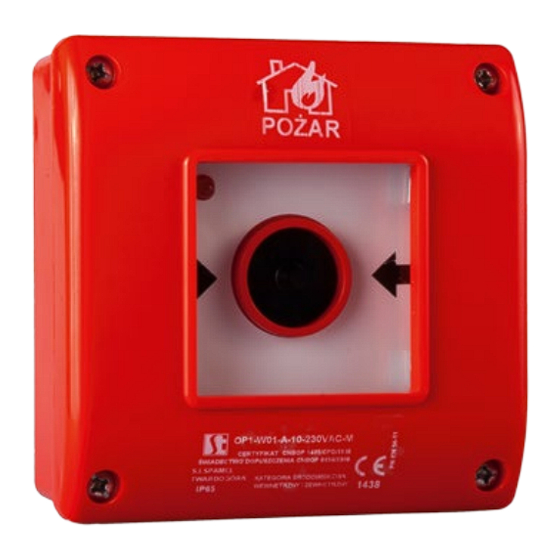
Advertisement
Quick Links
Emergency switches
Manual call point OP1
Product description
Manual call point (OP1) is intended for use in industry buildings and public
places. It is offered in two versions: flush and surface mounted. Each version
is available in two types: A and B. In OP1 type A the switch is released after
breaking the glass in an emergency. In OP1 type B, after breaking the glass the
momentary pushbutton must be pressed. Each enclosure can be fitted with
three switches SP22-10 (NO) or SP22-01 (NC). In addition, each assembly can
be fitted with a diode which can be connected to the switch or directly to the
alarm system in the building.
The signal is triggered and sent after breaking the glass (type A) or after breaking
the glass and pressing the momentary pushbutton (type B). The alarm signal is
reset after replacing the breakable element (glass - ordering code PPOŻ-5701).
The product is compliant with PN-EN 54-11.
Approval certificate No. 2266/2014.
Certificate of compliance EC No. 1438/CPD/0130.
Accessories
Hammer with a holder PPOŻ-1200\P01
Glass PPOŻ-5701\P01
Normally closed switch SP22\10
Normally closed switch ST22\01
Resistor board
Front panel label
More information on www.spamel.eu
Ordering code
OP1-
-
\
10, 20, 30
01, 02, 03
11, 12
21
Pushbutton type
A
triggered automatically after breaking the glass
B
after breaking the glass press the button manually
Version
W01 surface mounting
W02 flush
Code examples
OP1-W01-A-11
on-plaster mounting, 1 NO switch and 1 NC switch. When the glass is broken the pushbutton is
released automatically (type A acc. to PN-EN 54-11)
OP1-W02-B-10-230-M
flush mounting with 1 NO switch. When the glass is broken it is necessary to push the button
(type B acc. to PN-EN 54-11). Signalling LED 230 V AC. With a hammer.
Note
The type (A or B) must be taken into account when choosing the circuits
TYPE A
Normally open: the circuit is closed when the cover with a glass is mounted
- the button is pressed.
the circuit is open when the cover with a glass is not mounted or the glass is
broken - the button is not pressed.
Normally closed: opening and closing are opposite to the normally open
circuit
TYPE B
Normally open: closed state (closed circuit) is when the button is pressed.
Before that the cover with a glass must be disassembled or the glass broken
and the button must be pressed.
open state (open circuit) is when the cover with a glass is mounted or not
mounted or the glass is broken but the button is not pressed.
Normally closed: opening and closing are opposite to the normally open
circuit
Technical data
Rated insulation voltage U
Rated continuous current I
Rated operational current
I
for AC-15
e
Rated operational current
I
for AC-13
e
Protection level
Wire gauge
EMERGENCY SWITCHES
Hammer
without hammer
-M with hammer
Signalling
without signalling
-24
with signalling LED 24V AC/DC
-230
with signalling LED 230V AC
-P24
with PULSATING LED 24V DC
(pulsating frequency 2 Hz)
Switches
500 V
i
=I
10 A
u
th
2.5 A (230 V)
1.6 A (400/500 V)
4 A (24 V)
1 A (110 V)
0.25 A (220 V)
IP65 – declared by the manufacturer
(the selected feature of the product was
not confirmed by CNBOP-PIB)
OP1 is properly protected against
water according to the standard:
PN-EN60068-2-30
2× 1...2.5 mm² (solid)
0.75...1.5 mm² (stranded)
29-8-2018
Advertisement

Summary of Contents for Spamel OP1
- Page 1 Normally open: the circuit is closed when the cover with a glass is mounted is available in two types: A and B. In OP1 type A the switch is released after breaking the glass in an emergency. In OP1 type B, after breaking the glass the - the button is pressed.
- Page 2 Emergency switches EMERGENCY SWITCHES Dimensions surface mounting Spacing of xing holes Space for a gland flush mounting More information on www.spamel.eu 29-8-2018...
Need help?
Do you have a question about the OP1 and is the answer not in the manual?
Questions and answers